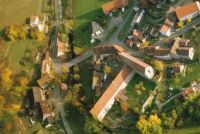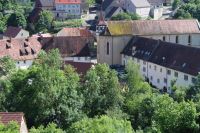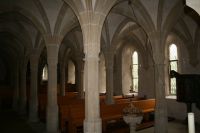You are here:
Abbeys > Germany > Baden-Württemberg > Frauental
Frauental


 Frauental
FrauentalFrauental is an idyllic village nestling between the little brook Steinach and a small valley, the river Tauber is about 5km away. The landscape in this area is known as Hohenloher Ebene, a high plain formed during the Middle Trias with limestone and shell stone.
The convent in Frauental was founded in 1232 by the brothers Konrad and Gottfried of Hohenlohe-Brauneck. When the Cistercian Order took over the convent, the administration was managed from the abbey in Bronnbach.
In 1448 the property rights around Frauental changed and was taken over by the Franconian branch of the House of Hohenzollern.
At the beginning of the Protestant Reformation in 1525 the House of Hohenzollern liquidated all convents and abbeys in their territory and Frauental was changed into a district and administrated by a bailiff. In 1584 on the east side of the church the annex Ansbacher Neubau (with coat of arms of the House of Hohenzollern) was added to the original building.
In 1670 farmers settled around the convent and so it slowly turned into the village Frauental. Since 1810 Frauental was ruled by the Kingdom Württemberg and later on the state of Baden-Württemberg with close borders to Bavaria.
Buildings
During the German Peasants' War in 1525 the convent was hit by the revolts very badly and only The nun gallery, a wooden ceiling in the upper church, is now used as a museum (From convent to village).
Below is the most beautiful part of the church, the lower church with three aisles, seperated by the upper church by a wall. Its low-ceilinged small crypt church is build on three rows of octagonal pillars to support the ribbed vault. The narrow aisles and the amount of pillars in this small hall causes a solemn atmosphere in this part of the church.
This was also the gravesite of the Hohenloher founders of the convent. Their epitaphs has been destroyed in the 18th century.
The grave stones you see today in the church are from former bailiffs who also donated the baroque baptismal font.
This part of the church is still used for church service.
One of the treasures in the upper church choir are three late-gothic figures and in the lower church two mummies, naturally preserved through environmental conditions.
The convents east wing is inhabited today by juvenile delinquents to give them education (Project Chance ). From there its possible to visit the remains of the cloister and the former convent garden.
[ Back ]
